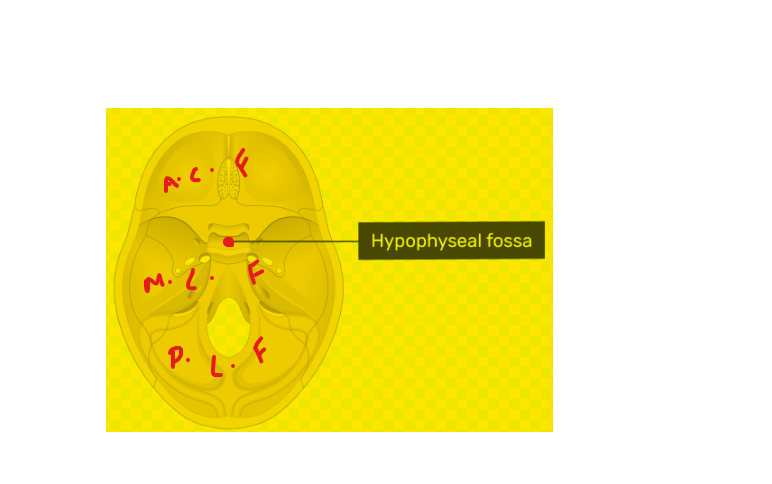Quick Overview
The hypophyseal fossa, also known as the sella turcica, is a saddle-shaped depression in the sphenoid bone of the skull that houses the pituitary gland. The pituitary gland is a small but important gland that produces a variety of hormones that regulate many bodily functions, including growth, metabolism, and reproduction.

Table of Contents
Anatomy of Hypophyseal Fossa
The hypophyseal fossa is located in the center of the sphenoid bone, directly below the hypothalamus. It is bordered by the tuberculum sellae anteriorly, the dorsum sellae posteriorly, and the clinoid processes laterally.
The hypophyseal fossa is lined with a dura mater sac, which is a tough membrane that protects the pituitary gland. The sac is also filled with cerebrospinal fluid, which cushions and supports the gland.
Location
The hypophyseal fossa is located in the center of the sphenoid bone, directly below the hypothalamus. It is located in the middle cranial fossa, between the anterior cranial fossa (above) and the posterior cranial fossa (below).
Boundaries
It is formed by the following structures:
Anteriorly: Tuberculum sellae
Posteriorly: Dorsum sellae
Laterally: Clinoid processes
Read also Middle Cranial Fossa and Cubital fossa
Structures
The Hypophyseal Fossa primarily houses the pituitary gland, a vital endocrine organ responsible for producing and regulating hormones that influence various bodily functions. It consists of two main parts, i,e the anterior pituitary (adenohypophysis) and the posterior pituitary (neurohypophysis). The anterior pituitary releases hormones that regulate growth, metabolism, reproduction, and more, while the posterior pituitary stores and releases hormones like oxytocin and vasopressin.
Clinical Significance
The clinical significance of the Hypophyseal Fossa is profound, as any disruption or pathology in this region can have wide-ranging effects on hormonal balance and bodily functions. Tumors within the pituitary gland, known as pituitary adenomas, can lead to hormonal imbalances and a range of health issues. Surgical interventions to address pituitary tumors often involve accessing the hypophyseal fossa to remove or treat these growths.
Associated Conditions
- Pituitary Tumors: These are the most common conditions related to the hypophyseal fossa. Pituitary tumors can be benign (non-cancerous) or, less commonly, malignant (cancerous). They can lead to hormone imbalances, affecting various bodily functions. Common types of pituitary tumors include prolactinomas, growth hormone-secreting tumors (acromegaly), and ACTH-secreting tumors (Cushing’s disease).
- Hypopituitarism: This condition arises when the pituitary gland fails to produce one or more of its hormones adequately. It can result from damage to the pituitary gland, often due to tumors, surgery, radiation therapy, or other causes. Hypopituitarism can lead to deficiencies in various hormones, affecting metabolism, growth, and reproductive functions.
- Empty Sella Syndrome: This condition occurs when the sella turcica appears empty or partially empty on imaging studies, despite the presence of the pituitary gland. It can be caused by increased pressure in the brain (intracranial hypertension) or by herniation of the arachnoid membrane into the sella turcica.
- Pituitary Apoplexy: Pituitary apoplexy is a medical emergency characterized by the sudden hemorrhage or infarction (tissue death) of the pituitary gland. This can lead to severe headache, vision disturbances, hormonal imbalances, and potentially life-threatening complications if not treated promptly.
Questions
Q.1- What is the Hypophyseal Fossa, and where is it located?
The Hypophyseal Fossa, also known as the Sella Turcica, is a small depression within the sphenoid bone, centrally located in the cranial vault. It cradles and protects the pituitary gland, a vital endocrine organ.
Q.2- What is the function of the pituitary gland within the Hypophyseal Fossa?
The pituitary gland, located in the Hypophyseal Fossa, controls and regulates various bodily functions by producing and releasing hormones. It influences growth, metabolism, reproduction, and many other physiological processes.
Q.3- What conditions or disorders are associated with the Hypophyseal Fossa?
Conditions related to the Hypophyseal Fossa include pituitary tumors or adenomas, which can disrupt hormonal balance and lead to symptoms like hormonal imbalances, headaches, and vision problems.
Q.4- How are pituitary gland issues diagnosed and treated?
Diagnosis typically involves imaging studies such as MRI or CT scans. Treatment options vary but may include medication, surgery, or radiation therapy, depending on the specific condition and its severity.
Q.5- What is the significance of the bony boundaries of the Hypophyseal Fossa, such as the clinoid processes and sphenoid sinuses?
These bony structures provide protection and structural support to the Hypophyseal Fossa. The clinoid processes, both anterior and posterior, help encase the pituitary gland, while the sphenoid sinuses surrounding the fossa enhance its resilience.
